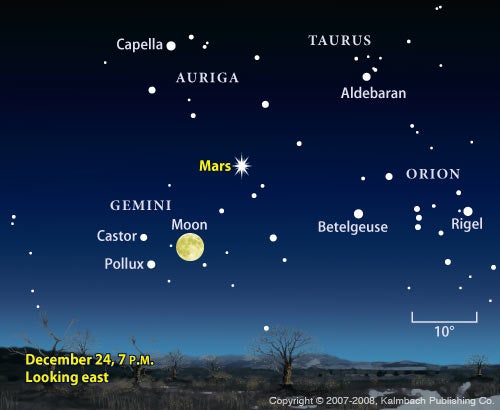
The Full Moon helps observers find Mars. On December 23, the Moon sits just 1° from the planet. One degree is equal to 2 Moon-diameters. Observers can also track Mars’ westward motion against the stars of Gemini. “Use binoculars, and about every other night, see which stars lie close to Mars,” says Astronomy Senior Editor Michael Bakich. “By doing this, observers can learn about planetary motion.”
Even under urban skies with heavy light pollution, it will be easy to see martian details with a small telescope.
Mars’ closest point to Earth comes December 18, when it lies 54.8 million miles away. Opposition and closest approach don’t coincide because Mars has a noticeably elliptical orbit.
Mars will look almost as bright several weeks before and after December 24. Let Santa be the only one to worry if Christmas Eve presents a cloudy sky.
More resources from Astronomy.com:
- Astronomy news
Astronomy basics
Glossary of astronomical terms
Return to Astronomy “For the media” page
WAUKESHA, WI — Christmas Eve will bring a lot more than Santa this year. Mars shines brightest and remains visible all night when it reaches opposition December 24. That night, the Red Planet shines brighter than any star; only the Full Moon and Venus will outshine it. An opposition occurs when Mars lies opposite from the Sun, becoming fully illuminated. Mars’ oppositions happen roughly every 780 days.
Mars won’t be this big or bright again until 2016. No equipment — just warm clothes — will be needed to enjoy this spectacle.
Astronomy magazine editors are available to discuss this spectacle. To request an interview, please contact Matt Quandt at 262.798.6484 or mquandt@kalmbach.com.
Astronomy‘s mission:
Astronomy promotes the science and hobby of astronomy through high-quality publications that engage, inform, entertain, and inspire.









